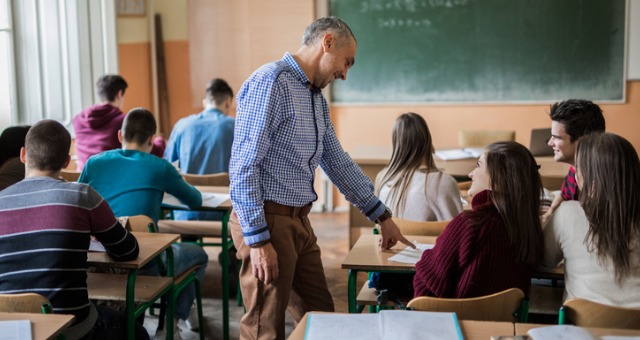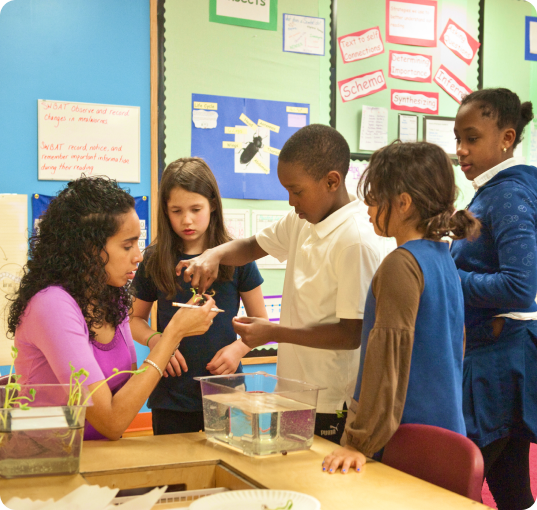Exploring the Different Teaching Methods in Key Scientific Research Education Today
The landscape of key scientific research education is developing, with different teaching techniques obtaining importance in contemporary classrooms. Inquiry-based knowing, hands-on experiments, and the integration of modern technology are redefining how instructors involve young minds. Additionally, collective approaches and separated instruction are being employed to satisfy the diverse needs of pupils, boosting both interaction and understanding. As we check out these techniques, inquiries emerge about their effectiveness and the ramifications for future academic practices. What might these shifts in strategy mean for the next generation of learners?
Inquiry-Based Understanding
Inquiry-Based Discovering (IBL) is an instructional strategy that encourages pupils to discover scientific principles via wondering about, investigation, and hands-on experimentation. This method emphasizes the role of trainees as active participants in their understanding, advertising important thinking and analytic skills. By engaging with real-world inquiries, trainees end up being inspired and curious, which improves their understanding of clinical principles.
In IBL, instructors function as facilitators, leading trainees as they browse their queries instead than supplying information straight. This student-centered method enables distinction, fitting numerous finding out speeds and designs. Pupils establish abilities in formulating theories, developing experiments, and examining information, which are critical for scientific proficiency.
In addition, IBL promotes partnership among trainees, encouraging them to share findings and concepts. This collective questions advertises social skills and a feeling of community within the class. The process of query motivates resilience, as students discover to embrace failure as a tipping rock towards understanding.
Hands-On Experiments
Hands-on experiments are a crucial component of effective science education, matching the principles of inquiry-based understanding. These experiments allow students to engage straight with scientific principles, fostering a deeper understanding through experiential discovering. By adjusting products and observing results, young students can grasp abstract concepts in concrete means.
Such tasks promote critical reasoning and problem-solving skills, as trainees hypothesize outcomes, conduct experiments, and assess outcomes. This procedure motivates them to ask questions, refine their understanding, and develop a scientific attitude. In addition, hands-on experiments can be tailored to diverse understanding designs, making certain that all trainees have the possibility to involve meaningfully with the content.
Moreover, hands-on experiments usually urge collaboration amongst peers, advertising teamwork and communication skills. Functioning in groups allows trainees to share concepts, talk about findings, and gain from one an additional, which improves their general academic experience.
Including hands-on experiments into the key science curriculum not only improves the learning environment however additionally grows a long-lasting passion in scientific research. By proactively taking part in their education and learning, students are more probable to develop an enthusiasm for scientific inquiry that expands beyond the classroom.

Modern Technology Integration
Incorporating technology right into key scientific research education and learning has actually ended up being increasingly necessary in cultivating student involvement and boosting finding out results. The use of electronic tools, such as interactive simulations, digital laboratories, and instructional software program, offers trainees with chances to check out clinical ideas in cutting-edge ways. These resources assist in a deeper understanding of complex subjects by allowing learners to imagine and control variables that would be impractical in a typical classroom setup.
Additionally, technology integration urges individualized discovering experiences. Pupils can progress at their very own pace, revisiting difficult principles with multimedia resources, which cater to various understanding styles. This flexibility not just supports individual growth but also grows a feeling of autonomy in students.
Furthermore, innovation functions as a bridge to real-world science, connecting pupils with present research study and expert payments. Access to click over here on the internet data sources and scientific journals broadens students' point of views on clinical query and cultivates important assuming abilities.
Collaborative Knowing
Joint knowing plays an important function in primary science education and learning by cultivating synergy and communication skills amongst trainees. This method encourages students to interact, share understanding, and participate in problem-solving, which boosts their understanding of scientific concepts. By taking part in group tasks, pupils discover to express their concepts, listen to diverse viewpoints, and negotiate services, every one of which are essential abilities in both academic and real-world contexts.

Study suggests that collaborative learning can lead to increased inspiration and engagement in science topics, as trainees find satisfaction in shared experiences (primary science tuition Singapore). Additionally, this method prepares students for future collaborative undertakings, outfitting them with the abilities essential for reliable team effort in college and professional settings. Ultimately, accepting joint discovering in key science education can substantially enhance the knowing experience and promote a much deeper understanding of scientific query
Set Apart Direction

Set apart direction can show up in different means, such as differing the material, processes, or items of knowing. For example, instructors Click Here might make use of tiered jobs that supply varying degrees of intricacy, permitting pupils to work at their respective preparedness levels. In addition, flexible organizing techniques can help with cooperation among students with different capacities, fostering peer knowing.
Evaluation plays a crucial duty in this method, as it educates guideline and assists educators comprehend each student's special requirements. Developmental evaluations, such as observations and quizzes, can guide teachers in readjusting their techniques to boost learning results. primary science tuition Singapore. Ultimately, by implementing distinguished direction in main science education and learning, teachers can grow an extra fair and effective knowing environment, encouraging all pupils to reach their complete possibility in comprehending scientific phenomena
Final Thought
In recap, the diverse training techniques in main scientific research education and learning, including inquiry-based learning, hands-on experiments, modern technology integration, joint discovering, and separated direction, jointly contribute to a much more effective knowing setting. These techniques promote important thinking, analytic skills, and a much deeper comprehension of scientific ideas. By carrying out these strategies, teachers can create encouraging and appealing class that resolve the varied needs of pupils, inevitably cultivating a lifelong passion in science and enhancing academic accomplishment.
Inquiry-Based Learning (IBL) is an website link instructional strategy that urges trainees to check out clinical ideas with wondering about, examination, and hands-on experimentation.Joint understanding plays a vital role in key science education by cultivating teamwork and interaction skills amongst trainees.Study indicates that collective knowing can lead to enhanced inspiration and interaction in scientific research topics, as pupils locate enjoyment in common experiences.In fostering an inclusive knowing setting, set apart instruction emerges as a vital strategy to accommodate the varied needs and capabilities of students in primary science education and learning. Eventually, by executing distinguished direction in key scientific research education, instructors can grow an extra equitable and effective knowing setting, equipping all trainees to reach their complete capacity in understanding clinical phenomena.